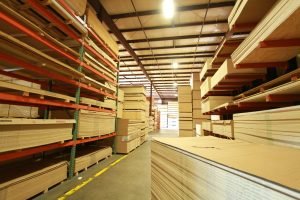Birch plywood is a high-performance wooden board widely used in furniture manufacturing, architectural decoration and industrial materials. The following is a detailed introduction to its material source and manufacturing process:
Material source
-Raw materials: The main raw material is birch (Betula tree), which is hard, tough, and has good mechanical properties and stability. Birch (scientific name: Betula), a plant of the genus Betula in the family Betulaceae, is mainly distributed in the northern temperate zone, and a few species are distributed in the Arctic region. It is cold-resistant, fast-growing, and relatively immune to pests and diseases. It is used for reforestation, soil erosion control, protective covering, or as a conservation tree.
The wood is pure and fine, slightly heavy and hard, with a fine structure, high mechanical strength, elasticity, and high hygroscopicity. It is mostly used in the form of plywood.
-Timber collection: Usually comes from fast-growing forests or evergreen forests, and is scientifically managed and harvested to ensure sustainable use of resources.
-Adhesive: Use environmentally friendly adhesives (such as phenolic resin, urea-formaldehyde resin, etc.), with high bonding strength, good durability, and meet environmental standards.
Manufacturing process
1.Wood preparation:
Cut birch raw materials into thin slices (veneers), with a thickness of generally between 0.3 and 1 mm.
Dry the wood slices and control the moisture content to 8%-12% to ensure the firmness of subsequent gluing.
2.Veneer cutting and sorting:
Cut the wood slices into the required size by a cutter.
Arrange the layers of veneers reasonably (usually an odd number of layers) according to the direction of the wood grain to enhance the stability and mechanical strength of the board.
3.Gluing:
Apply adhesive evenly on the joint surface of each layer of veneer.
Stack into a three-layer or multi-layer structure to ensure that each layer is firmly glued.
4.Hot pressing:
The stacked wood slices are hot pressed under high temperature and high pressure.
During the pressing process, the adhesive is fully cured to form a solid whole board.
5.Post-processing:
After hot pressing, cool, cut and polish.
Depending on the intended use, surface treatments such as veneer or painting may also be applied.
Structural advantages of birch plywood:
1.Strong stability and not easy to deform
Traditional solid wood is easily affected by changes in temperature and humidity in the environment, resulting in cracking or warping. Birch plywood adopts a criss-cross multi-layer superposition structure. This layer structure can effectively offset the stress inside the wood and reduce the risk of dimensional changes and deformation caused by environmental changes.
Therefore, birch plywood can maintain excellent dimensional stability and structural integrity in both dry and humid environments. It is particularly suitable for high-end furniture and can ensure the long-term use effect and appearance of furniture.
2.High strength and good load-bearing capacity
Although birch itself has moderate hardness, the plywood significantly improves the bending strength and impact resistance of the overall board through the mechanical superposition and high-strength gluing of multiple layers of thin boards. Compared with ordinary solid wood boards, birch plywood can withstand greater loads and external impacts, and the larger the size, the more obvious the advantage.
This makes birch plywood an ideal material for making large furniture (such as dining tables, bookcases, etc.) and structural parts that require load-bearing performance.
3.Environmentally friendly and sustainable
Birch has a short growth cycle and abundant resources, and is a sustainable wood resource. The manufacturing process of plywoods can make full use of birch materials, reduce wood waste, and take into account both environmental protection and economic benefits.
In addition, high-quality birch plywoods usually use environmentally friendly adhesives, such as glues that meet E0 standards. These glues have extremely low formaldehyde emissions, which meet the requirements of the high-end market for healthy and environmentally friendly products.
Therefore, birch plywoods not only have superior performance, but are also environmentally friendly and healthy, which meets the pursuit of sustainable development in modern furniture manufacturing.
Comparing birch plywood with other common wood materials highlights its advantages in both performance and application, especially in furniture making. Here’s a clear and professional yet easy-to-understand overview:
1.Particle Board / MDF (Medium-Density Fiberboard)
These boards are generally much cheaper than birch plywood and made from wood fibers or particles glued together under heat and pressure. However, their strength and durability are relatively low, making them prone to damage under heavy loads or impact. Additionally, particle board and MDF absorb moisture easily, which causes swelling and deterioration over time. Because of these drawbacks, they are unsuitable for high-end furniture that requires longevity and stability.
2.Solid Wood Boards
Solid wood is natural and offers excellent appearance and feel. However, it has some significant downsides:
-The cost is much higher compared to engineered products like plywood.
-It tends to warp, crack, or deform easily due to changes in humidity and temperature.
-Maintenance can be complicated and costly over time, as solid wood furniture requires regular care to preserve its appearance and performance.
While solid wood carries prestige and traditional appeal, these factors limit its practical use in many modern furniture contexts.
3.Other Plywood Types (Poplar, Pine)
While plywood made from poplar or pine is commonly used and relatively affordable, these woods generally have lower density and hardness than birch. As a result, plywood from these species may feel less solid and visually less refined. By contrast, birch plywood offers superior density and hardness, delivering a more premium feel and better surface quality. This makes birch plywood a preferred choice when a higher-end look, better durability, and finer craftsmanship are desired.
In summary, birch plywood strikes an excellent balance of strength, stability, appearance, and cost-effectiveness. It outperforms particle boards and MDF in durability, surpasses solid wood in dimensional stability and maintenance ease, and offers a higher-quality texture and feel compared to plywood made from softer wood species. This combination makes it a top candidate for premium furniture and interior applications.
The selection logic for high-end furniture markets can be summarized as follows:
1.Balancing Aesthetics and Practicality
High-end consumers value not only the visual appeal but also the durability of furniture products. Birch plywood delivers the natural texture and premium feel of solid wood, while offering greater stability and resistance to deformation compared to pure solid wood. This provides a perfect combination that meets both the aesthetic and functional demands of discerning users.
2.Adaptability to Complex Craftsmanship
High-end furniture often features curved surfaces and irregular shapes. Birch plywood is easy to cut, carve, and bend, enabling manufacturers to realize intricate designs such as curved table legs and custom cabinetry. Its excellent workability makes it ideal for sophisticated craftsmanship that characterizes luxury furniture.
3.Brand Premium and Consumer Perception
Material choice directly influences brand positioning in the luxury market. Birch plywood, thanks to its superior performance and environmentally friendly qualities, is favored by many international furniture brands—including premium lines of IKEA and Italian luxury furniture makers. This preference reinforces birch plywood’s image as a high-end material, adding value and prestige to the finished products.
In summary, birch plywood aligns perfectly with the high-end furniture market’s priorities by offering a harmonious blend of beauty, durability, design flexibility, and brand-enhancing qualities.

